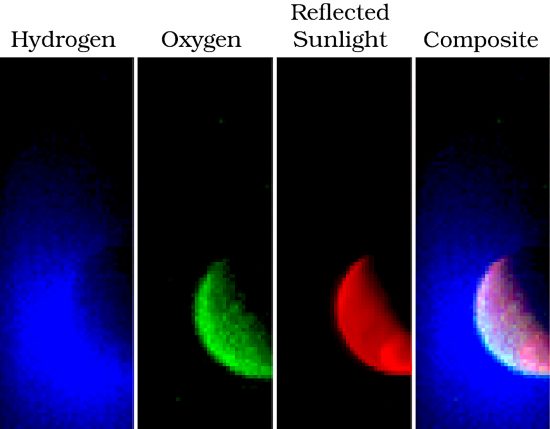
Blue indicates ultraviolet light from the sun. Green shows reflected sunlight. Red indicates ultraviolet sunlight reflected from the surface. Credit: Laboratory for Atmospheric and Space Physics /University of Colorado; NASA
Feb 3, 2017
Mars glows in high frequencies.
NASA launched the Mars Atmosphere and Volatile Evolution mission (MAVEN) on November 18, 2013. Maven is investigating the upper atmosphere of Mars, its ionosphere, and the dynamics of solar wind interactions.
Several onboard instruments are monitoring various phenomena:
* Solar Wind Electron Analyzer measures ionospheric electrons.
* Solar Wind Ion Analyzer measures magnetosheath ion density.
* Langmuir Probe determines ion escape wave heating and extreme ultraviolet input from the Sun.
* Ultraviolet Spectrometer measures characteristics of the upper atmosphere.
* Magnetometer to measure the Martian remanent magnetic field.
Four of the instruments are designed to gather data about electrical activity between Mars and the Sun, while the magnetometer will gather precise measurements of its variable magnetic field. Planetary scientists want to know how the loss of carbon dioxide, nitrogen dioxide and water vapor has changed Mars over the eons.
Maven is seeing Martian aurorae centered on regions near the South Pole that were first detected by the Mars Express mission. Although Mars has no intrinsic magnetic field, it does possess concentrated bands of crustal magnetism in its lower latitudes. Astrophysicists do not know what caused the peculiar magnetized stripes that seem to focus on a specific point in the south, or why the auroral events should be associated with them.
So-called “non-thermal radiation” is also seen emanating from the Martian surface. Since the energy readings were independent of the surface temperature, and occurred during one of the giant dust storms that sometimes rage through the southern plains, the assumption is that they are evidence for lightning discharges.
What causes Martian dust storms and why are they electrified? The air is 100 times thinner on Mars and averages 75 degrees colder than Earth. The environment appears to be bone dry, and Martian dust storms are larger than any seen on Earth. Occasionally, when Mars is closest to the Sun, dust obscures the whole planet.
When NASA studied dust devils in the Arizona desert in order to understand more about the ones that have been seen on Mars, they found an electric field of up to 10,000 volts per meter associated with dust devils on Earth. The normal fair weather electric field at the Earth’s surface measures 100 volts per meter. This suggests that dust devils on both Earth and Mars are atmospheric electric discharge phenomena similar to the electric breezes produced by “ionic wind” air purifiers.
Using MAVEN’s Langmuir Probe and Waves (LPW) instrument, researchers found a dust cloud in the Martian atmosphere at around 150 kilometers above the surface. This finding was a surprise. Laila Andersson from the University of Colorado wrote:
“If the dust originates from the atmosphere, this suggests we are missing some fundamental process in the Martian atmosphere.”
As mission specialists speculate, the dust could be “wafted up from the atmosphere” or it could be “debris orbiting the sun from comets”. However, no Martian activity can explain dust in the observed locations.
Dust storms occasionally engulf Mars. Martian dust devils draw finely divided dust up through thousands of funnels and carry it for hundreds of kilometers. NASA scientists assume that the non-thermal radiation was caused by electric charge building up in the sand grains that subsequently discharged as lightning, but that may not be the case.
In the Electric Universe theory, no collisions from bouncing sand grains are necessary. Charge separation already exists in the atmosphere. Without clouds like those on Earth to send lightning down to ground level, the electric discharges on Mars form giant whirlwinds that are part of an interplanetary electrical circuit. It is that same circuit that drives weather systems on Earth. If this is true, then Martian “dust devils” and those on Earth are both illustrations of how electricity behaves in the Solar System.
Electrons spiraling in a magnetic field emit synchrotron radiation, the most common type of “non-thermal” radiation. Whirling, electrically charged dust storms, spinning at hundreds of kilometers per hour, create intense magnetic fields that tend to confine the charged particles and accelerate them around the vortex at high speed. Rapid acceleration, coupled with high voltages in the dust causes the ultraviolet glow seen recently on Mars, along with the surge in energetic electrons at the onset of its aurora.
Stephen Smith












